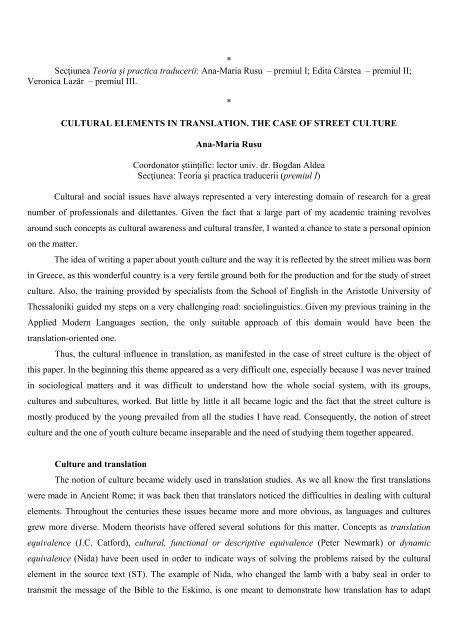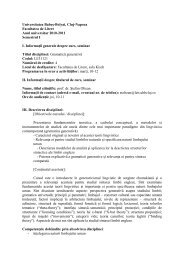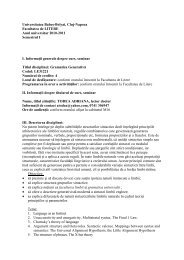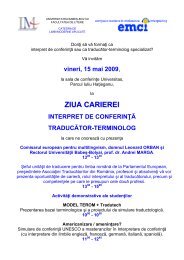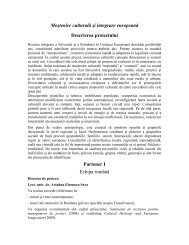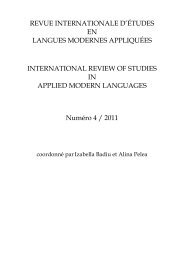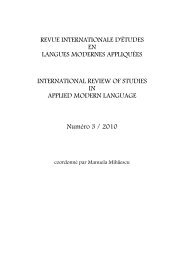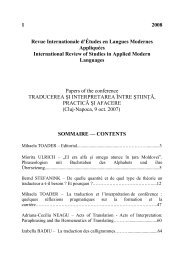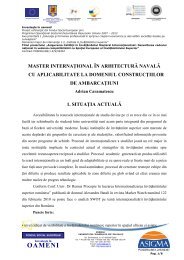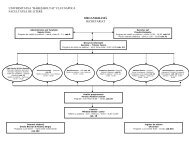Dimensiuni ale limbajului n context carceral
Dimensiuni ale limbajului n context carceral
Dimensiuni ale limbajului n context carceral
Create successful ePaper yourself
Turn your PDF publications into a flip-book with our unique Google optimized e-Paper software.
*<br />
Secţiunea Teoria şi practica traducerii: Ana-Maria Rusu – premiul I; Edita Cârstea – premiul II;<br />
Veronica Lazăr – premiul III.<br />
*<br />
CULTURAL ELEMENTS IN TRANSLATION. THE CASE OF STREET CULTURE<br />
Ana-Maria Rusu<br />
Coordonator ştiinţific: lector univ. dr. Bogdan Aldea<br />
Secţiunea: Teoria şi practica traducerii (premiul I)<br />
Cultural and social issues have always represented a very interesting domain of research for a great<br />
number of professionals and dilettantes. Given the fact that a large part of my academic training revolves<br />
around such concepts as cultural awareness and cultural transfer, I wanted a chance to state a personal opinion<br />
on the matter.<br />
The idea of writing a paper about youth culture and the way it is reflected by the street milieu was born<br />
in Greece, as this wonderful country is a very fertile ground both for the production and for the study of street<br />
culture. Also, the training provided by specialists from the School of English in the Aristotle University of<br />
Thessaloniki guided my steps on a very challenging road: sociolinguistics. Given my previous training in the<br />
Applied Modern Languages section, the only suitable approach of this domain would have been the<br />
translation-oriented one.<br />
Thus, the cultural influence in translation, as manifested in the case of street culture is the object of<br />
this paper. In the beginning this theme appeared as a very difficult one, especially because I was never trained<br />
in sociological matters and it was difficult to understand how the whole social system, with its groups,<br />
cultures and subcultures, worked. But little by little it all became logic and the fact that the street culture is<br />
mostly produced by the young prevailed from all the studies I have read. Consequently, the notion of street<br />
culture and the one of youth culture became inseparable and the need of studying them together appeared.<br />
Culture and translation<br />
The notion of culture became widely used in translation studies. As we all know the first translations<br />
were made in Ancient Rome; it was back then that translators noticed the difficulties in dealing with cultural<br />
elements. Throughout the centuries these issues became more and more obvious, as languages and cultures<br />
grew more diverse. Modern theorists have offered several solutions for this matter. Concepts as translation<br />
equiv<strong>ale</strong>nce (J.C. Catford), cultural, functional or descriptive equiv<strong>ale</strong>nce (Peter Newmark) or dynamic<br />
equiv<strong>ale</strong>nce (Nida) have been used in order to indicate ways of solving the problems raised by the cultural<br />
element in the source text (ST). The example of Nida, who changed the lamb with a baby seal in order to<br />
transmit the message of the Bible to the Eskimo, is one meant to demonstrate how translation has to adapt


